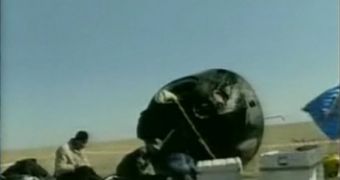Last Saturday, the Soyuz TMA-11 spacecraft carrying the crew of Expedition 16 back to Earth experienced a 'ballistic' re-entry into Earth atmosphere, thus subjecting the crew to forces up to 10 G and putting their lives in serious jeopardy. It was a bumpy ride, one might say, and the second in a row with a Soyuz capsule. Although the problem remains partly unknown and might have been determined by an electrical short circuit, NASA rushed to state that they are not worried with the performance of the Soyuz vehicles.
The steep re-entry of the spacecraft resulted in a landing more than 450 kilometers off the designated target, and a loss in communications with the crew for up to an hour during the descent. 25 minutes after the capsule landed, it was located and the astronauts on board were rescued. They are ex-International Space Station commander astronaut Peggy Whitson, flight engineer cosmonaut Yuri Malenchenko and astronaut So-yeon Yi, aged 29 and the first South Korean in space.
"We don't see this as a major problem, but it's clearly something that should not have occured, We don't like to see things repeat on two flights," said NASA associate administrator for space operations William H. Gerstenmaier during the press conference yesterday.
Short circuit
According to a Russian space official, the Soyuz capsule suffered serious heat damage during re-entry, testimony to the danger to which the crew was subjected. NASA on the other hand appears to be in the dark. "The Russian folks have not told me any of that. They're concerned about the event, but the relative danger to the crew we've had no discussion of that at all," explained Gerstenmaier.
It appears that the capsule's backup descent mode was accidentally enabled when a cable connecting the control panel to the hardware descent suffered an electrical short circuit, which may also be the cause for the previous steep descent of a similar capsule during October last year. The presumptions still remain to be confirmed.
Detachment delay
Alternatively, the investigation of the Soyuz TMA-10 spacecraft revealed a possible problem with the detachment of the propulsion module, which may have been delayed during the approach to Earth's atmosphere, thus changing the weight distribution across the vehicle and forcing it into a wrong re-entry trajectory, a potentially fatal glitch.
There is evidence that the same could have happened with the Soyuz TMA-11 spacecraft, and that the short circuit and the detachment delay are connected with each other somehow. "That's not the right leap to make yet. Let the Russians go ahead and get the data, analyze and understand what they've got and then we can talk about where we are," cautioned Gerstenmaier.
Bad timing
Simply put, the incident could have not come at a worst time. NASA is relying on the Russian Soyuz and Progress capsules, as they are expected to be retired by 2010. Until 2015, the US space agency will have no space transportation vehicle, and the expected Orion Crew Exploration Vehicle, currently in development, doesn't seem to promising at this moment.
If the Russian spacecrafts become obsolete, NASA may have to consider the commercial launch options as an alternative. "We don't have the luxury or the funding to go ahead and continue multiple launch systems. We'll work as hard as we can to get our CEV or get a commercial crew transportation capability online as soon as we can," said Gerstenmaier.

 14 DAY TRIAL //
14 DAY TRIAL //